The Complete Webflow to Shopify Migration Guide
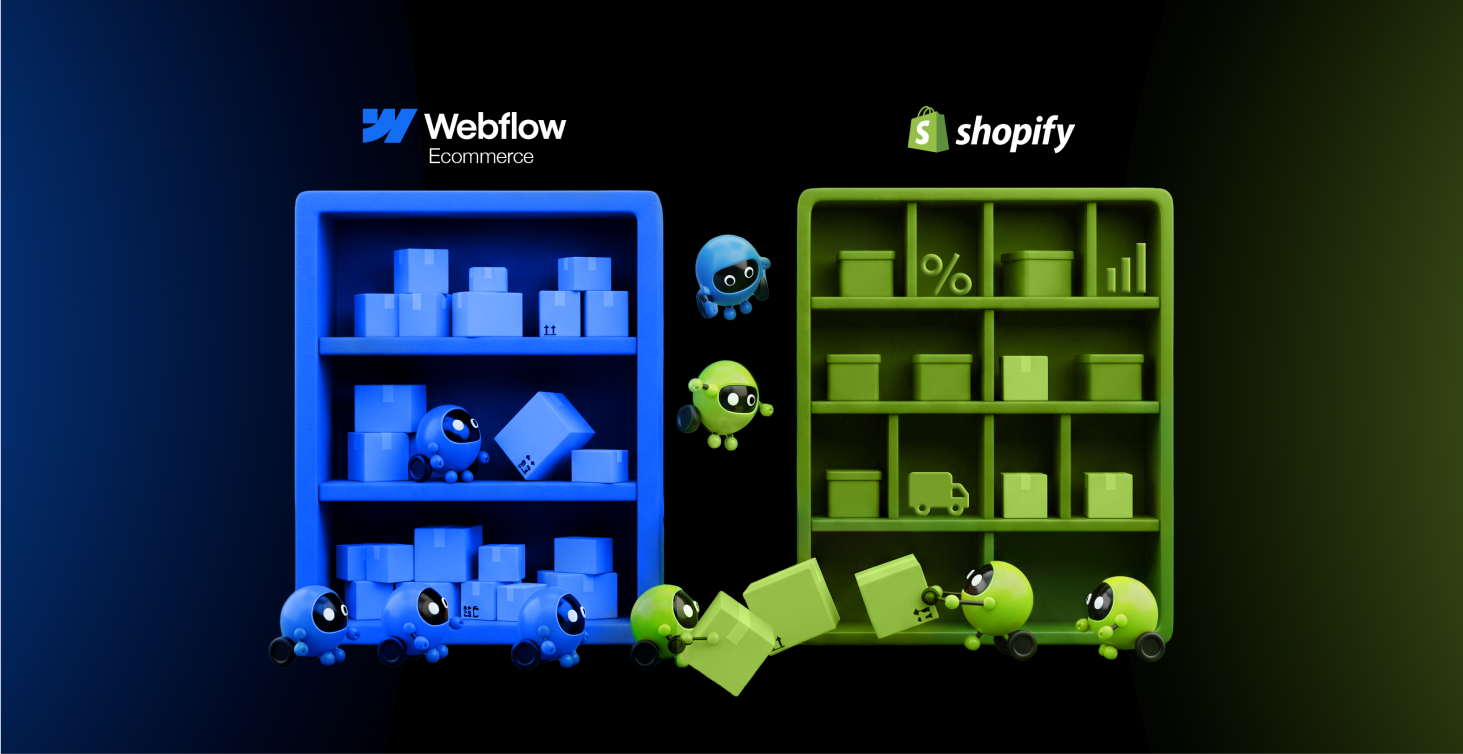
Webflow is arguably one of the best platforms around for its design capabilities. But e-commerce brands who value design will soon find themselves stuck with limitations on Webflow:
- Basic inventory and order management functionality that lacks the depth serious merchants need
- Limited shipping fulfillment network options compared to Shopify's extensive logistics infrastructure
- Payment methods restricted to primarily Stripe and PayPal vs Shopify's 100+ gateway options
- Surface-level analytics and reporting that doesn't match dedicated e-commerce analytics
- Simple discount features vs sophisticated promotional capabilities
- Basic marketing automations that fall short of comprehensive e-commerce marketing needs
- Limited third-party integrations vs Shopify's 12,320+ specialized e-commerce apps
- Lacks the advanced features needed for high-volume, complex operations.
Your first thought might be to migrate to Shopify, but you're up against some ugly compromises:
- Custom development dependency: Every design change requires hiring a developer, quality Liquid developers are rare and costly, and simple updates take weeks instead of minutes
- Generic ready-made themes: Look generic or require expensive custom development to match your brand
- Limited page builders: Apps like PageFly and GemPages can't match Webflow's design capabilities and you'll hit walls implementing complex layouts
- Complex headless stacks: Custom JavaScript development matches Webflow for customization but requires specialized teams and significant time and budget investment
What if you didn't have to choose?
There's a way e-commerce brands can leverage Webflow's incredible design power with Shopify's e-commerce muscle. Read on to find out exactly how. ⬇️
Why traditional migration isn't the answer
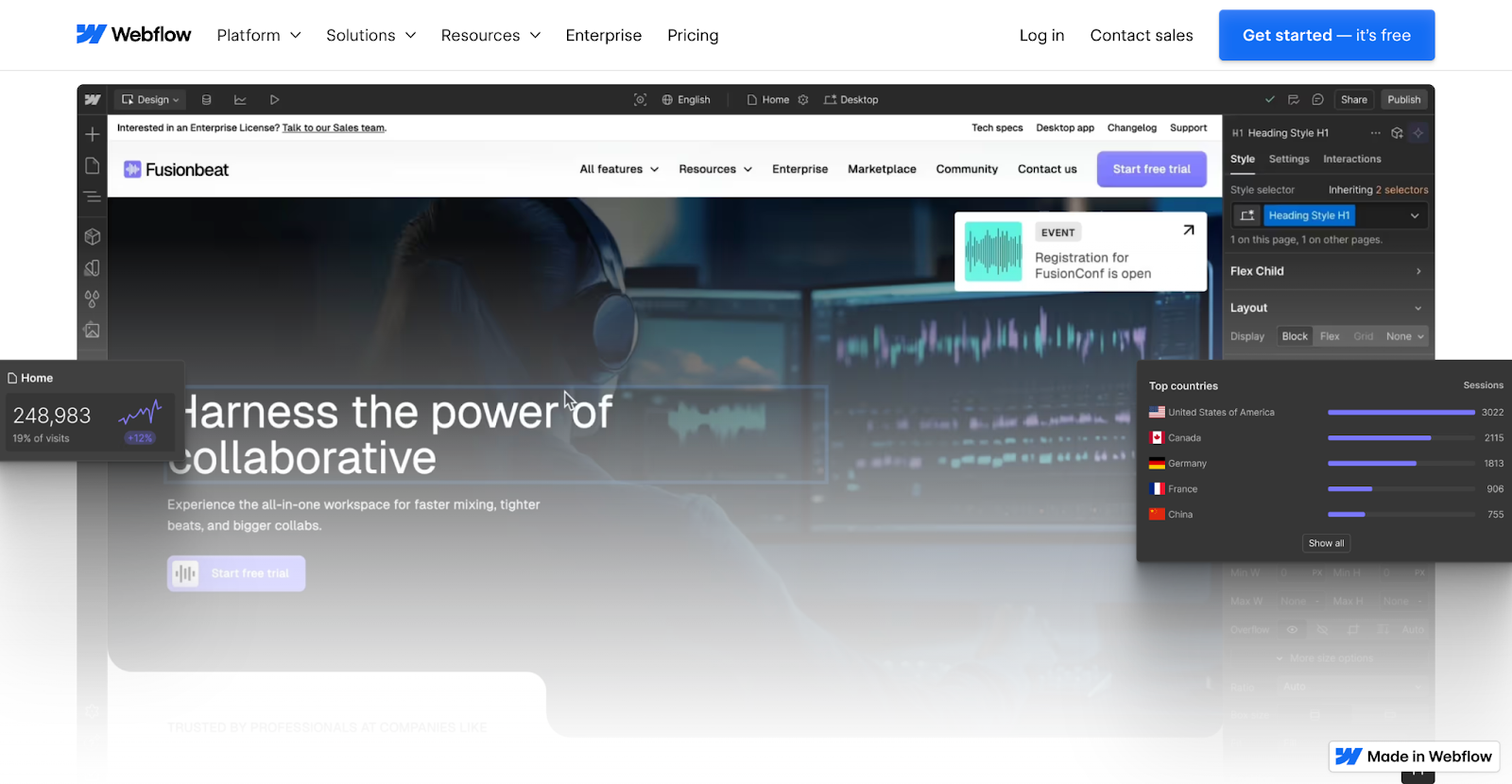
When faced with Webflow's e-commerce limitations, most businesses consider migrating to Shopify. But traditional migration creates more problems than it solves – forcing you to sacrifice everything that made your Webflow site successful in the first place.
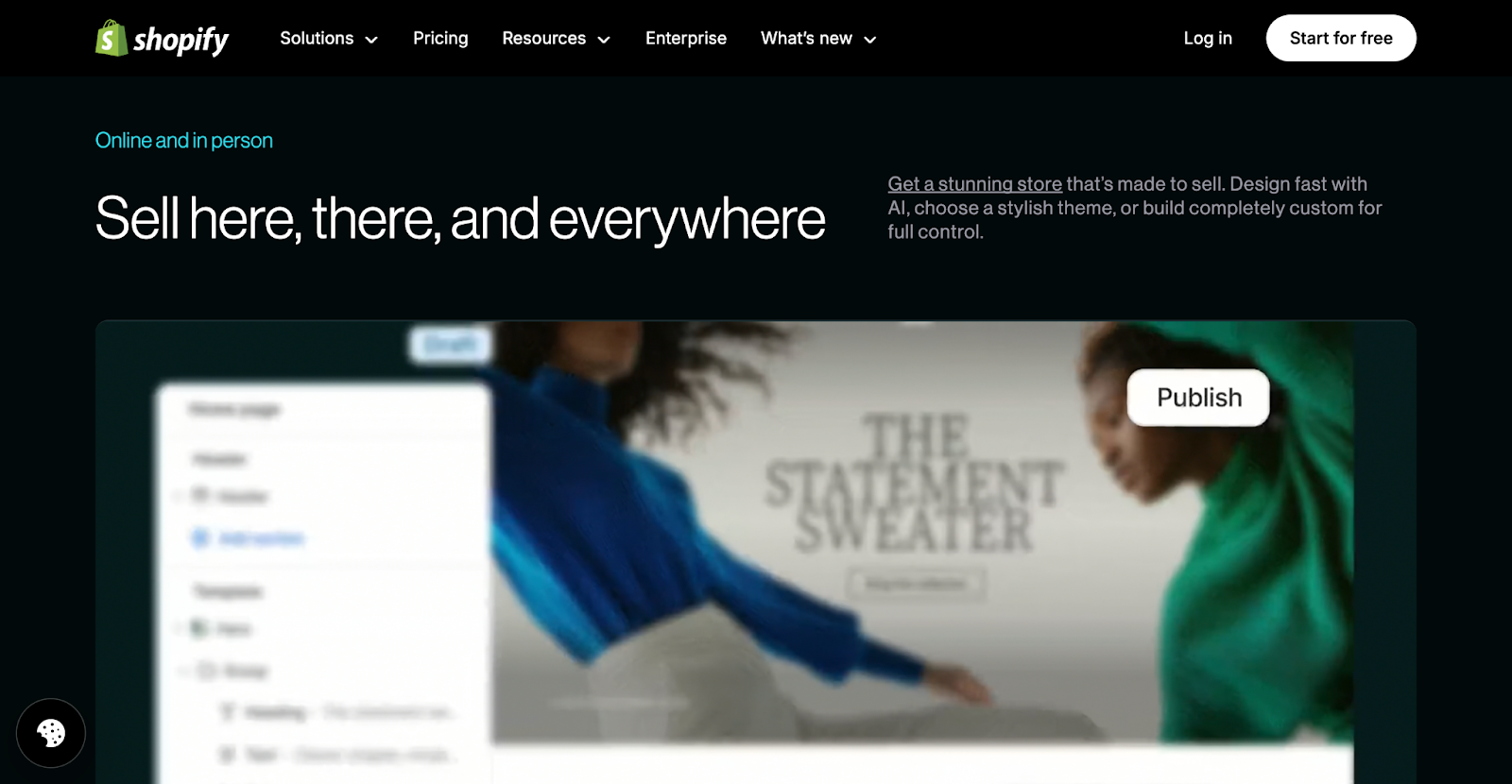
The financial cost is staggering
💵 $5,000-$25,000 to recreate custom Webflow designs in Shopify themes or custom development. This doesn't include the opportunity cost of lost sales during the transition period or the ongoing maintenance costs that come with custom code.
💵 4-8 weeks minimum timeline with significant business disruption. During this period, you can't make updates to your site, launch new campaigns, or respond quickly to market changes.
💵 Team learning curve and productivity loss as your team adjusts to new workflows, admin interfaces, and development processes.

You'll also need to pay for additional tools and ongoing development:
- Page builder apps like PageFly, Shogun, or GemPages: $29-$99/month
- Advanced features and templates: Additional $20-50/month
- Section customization apps: $15-30/month
- Advanced product page builders: $25-45/month
- Custom form builders: $10-25/month
Or if you don't want to wrestle with page builders, you'll need ongoing Liquid developer support:
- Basic design modifications: $500-1,500/month
- Ongoing maintenance and updates: $200-800/month
- Custom feature development: $1,000-3,000+ per project
Yes, it can amount up to a lot of dollars.
The technical risks are significant
A large amount of migrations lose organic traffic without expert SEO handling. Even with careful planning, changes in URL structure, site architecture, and technical implementation can hurt your search rankings.
4-12 weeks of potential traffic loss and ranking fluctuations as search engines reindex your new site structure.
Technical debt accumulates quickly – customizations require Liquid development skills and ongoing maintenance. What seems like a simple change often requires developer intervention.
Limited inventory and order management capabilities
One of the biggest limitations businesses face on Webflow is the basic inventory and order management functionality.
Webflow's e-commerce features work for simple stores, but they fall short for businesses that need advanced inventory tracking, bulk operations, or sophisticated order management workflows.
Serious merchants need features like:
- Multi-location inventory tracking across warehouses and retail locations
- Automated low-stock alerts and reorder points
- Bulk inventory updates and product management tools
- Advanced order status tracking and fulfillment workflows
- Integration with warehouse management systems
- Sophisticated reporting on inventory turnover and product performance
Webflow simply doesn't offer these capabilities, forcing growing businesses to manage inventory manually or look for external solutions that don't integrate seamlessly.
Restricted payment options limit global growth
Webflow's payment methods are restricted to primarily Stripe and PayPal, while Shopify offers 100+ gateway options.
This limitation becomes critical when expanding to international markets or serving customers who prefer alternative payment methods.
Modern e-commerce businesses need access to:
- Buy Now Pay Later options (Klarna, Afterpay)
- Digital wallets (Apple Pay, Google Pay, Amazon Pay)
- Regional payment processors for international markets
- Cryptocurrency payment options
- Bank transfer and invoice payment methods for B2B customers
- Local payment methods that customers trust in specific regions
Without these options, businesses on Webflow miss out on sales and struggle to compete in global markets where payment preferences vary significantly.
Surface-level analytics hold back data-driven decisions
Webflow provides basic sales data, but serious merchants need deep insights into customer behavior, product performance, and marketing attribution.
Dedicated e-commerce platforms like Shopify offer:
- Customer lifetime value calculations and cohort analysis
- Product performance metrics and profit margin analysis
- Marketing attribution across multiple channels
- Abandoned cart analysis and recovery insights
- Customer segmentation based on purchase behavior
- Inventory turnover and demand forecasting
- Sales funnel analysis and conversion optimization data
These insights are crucial for making informed business decisions, optimizing product offerings, and improving marketing ROI.
Simple promotional capabilities limit marketing effectiveness
Creating complex promotional strategies requires functionality that Webflow simply doesn't offer.
While Webflow provides basic discount codes, sophisticated e-commerce marketing needs:
- Tiered discounts based on order value or quantity
- Customer-specific pricing for VIP or wholesale customers
- Time-sensitive flash sales with countdown timers
- Bundle deals and cross-sell promotions
- Loyalty program integration with points and rewards
- Automatic discounts based on customer behavior
- Advanced coupon systems with usage limits and restrictions
These promotional tools are essential for driving sales, increasing average order value, and building customer loyalty.
Basic marketing automations miss conversion opportunities
Email sequences, abandoned cart recovery, customer segmentation, and lifecycle marketing require specialized tools that integrate seamlessly with your store data.
Webflow's basic automation capabilities can't compete with dedicated e-commerce marketing tools that offer:
- Sophisticated abandoned cart recovery sequences
- Post-purchase follow-up campaigns
- Customer win-back campaigns for inactive buyers
- Product recommendation engines based on purchase history
- Birthday and anniversary marketing campaigns
- Re-engagement campaigns for dormant customers
- Advanced segmentation based on purchase behavior and preferences
These automations are crucial for maximizing customer lifetime value and reducing the cost of customer acquisition.
You’re also forced to rebuild marketing pages, custom forms, complex layouts, interactive sections, and animations within Shopify theme limitations. The design elements that set your brand apart and drive conversions often can't be replicated in Shopify's theme system.
You lose a lot overall when going from Webflow to Shopify
The differences between these platforms go far beyond just technical features. You're fundamentally changing how your team works and how your brand is expressed online.
Shopify's Liquid templating vs Webflow's visual design control creates a completely different workflow that's less intuitive for designers. Moving from Webflow's drag-and-drop interface to code-based customization means longer development cycles and higher costs for every design change.
Interactive elements that took months to perfect often can't be recreated without extensive custom development. Those smooth animations, custom hover effects, and interactive sections that make your brand memorable become expensive development projects instead of simple visual adjustments.
Webflow's precision vs theme-based constraints means you lose the ability to control every pixel of your design. Instead of perfect spacing and pixel-perfect layouts, you're working within the limitations of pre-configured themes that rarely match your exact vision.
CMS collections don't map perfectly to Shopify's product-focused architecture, especially for content-heavy sites or complex data structures. If your Webflow site uses custom collections for portfolios, case studies, or complex content relationships, rebuilding this functionality in Shopify requires significant workarounds.
Team retraining on new platform and development processes reduces productivity and increases the learning curve for everyone involved. Your marketing team loses the ability to make quick updates, your designers need to learn Liquid templating, and everyone becomes dependent on developers for changes that used to take minutes.
💡 Before considering traditional migration, calculate the total cost including development, apps, ongoing maintenance, and potential traffic loss. Most businesses find the numbers don't add up when they factor in all the hidden costs.
How to migrate from Webflow to Shopify without losing out

Instead of forcing you to choose between Webflow's design capabilities and Shopify's e-commerce power, Shopyflow creates a seamless integration that gives you the best of both platforms.
Here's what stays exactly the same:
- Every marketing page, layout, form, integration, interactive section, and animation stays exactly as you designed it. Your brand experience remains intact.
- Access to Shopify's core e-commerce features and compatible apps from the app ecosystem without rebuilding your frontend.
- Your existing Webflow site remains your main storefront – customers never know they're shopping across two platforms.
- There’s no data transfer, no downtime, no SEO risk, no design rebuilding required. Your site continues operating normally throughout the setup process.
How checkout works with Shopyflow
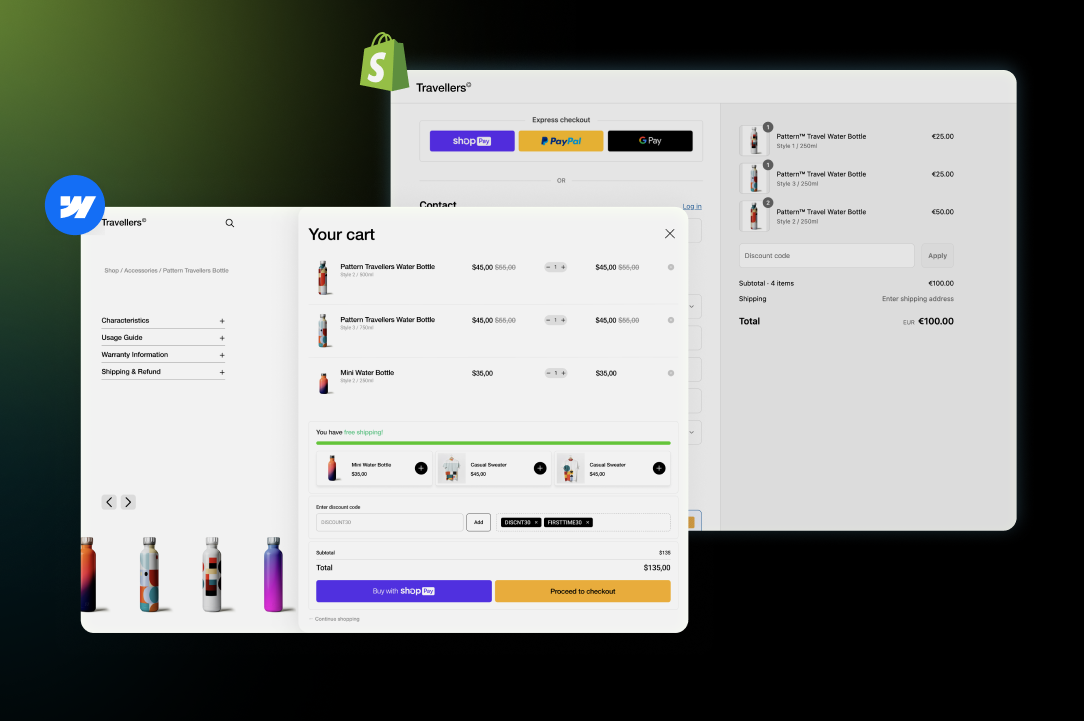
The customer experience is seamless and optimized for conversions:
Customers browse and shop on your beautiful Webflow site, experiencing all your custom design, animations, and brand storytelling. When they're ready to purchase, they're seamlessly redirected to Shopify's secure checkout to complete their purchase.
This approach gives you:
- Shopify's conversion-optimized checkout that's proven to perform better than most custom implementations
- All payment methods including Apple Pay, Google Pay, Buy Now Pay Later options, and 100+ payment gateways
- Secure payment processing with fraud protection handled by Shopify's enterprise-level infrastructure
- Order management through Shopify admin where you can handle fulfillment, customer service, and analytics
How Shopyflow works
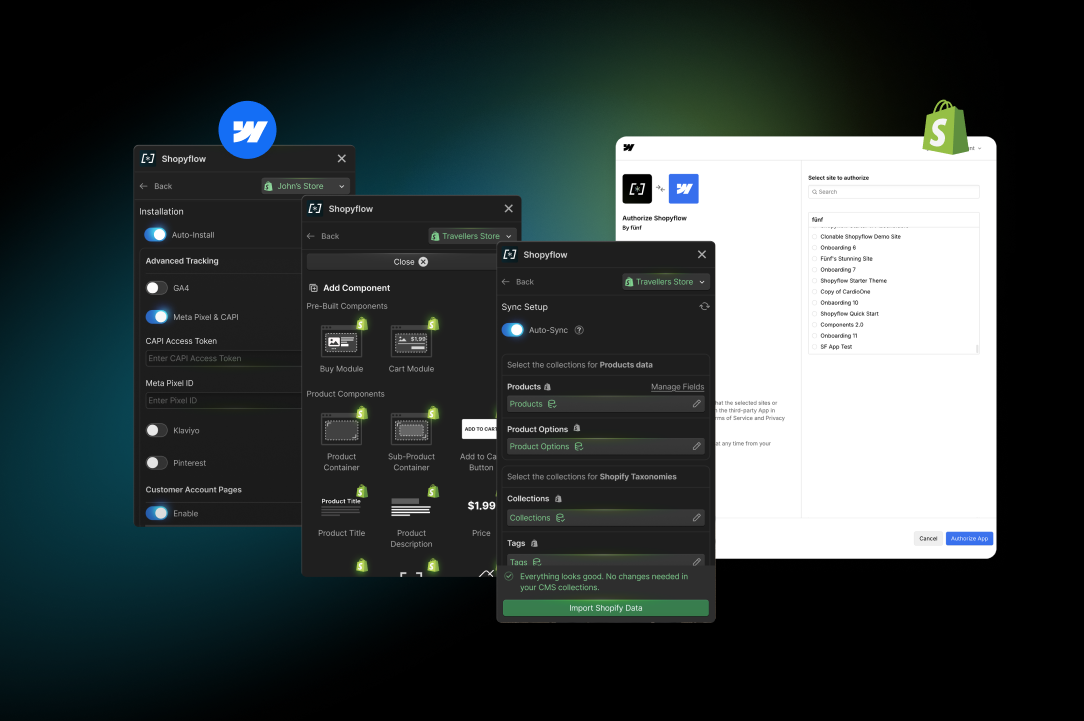
Your products live in Shopify
You add and manage all your products in Shopify just like a normal Shopify store. Set prices, inventory levels, descriptions, images, and variants using Shopify's familiar interface.
Use any compatible Shopify apps you need for marketing automation, advanced analytics, inventory management, or specialized functionality.
Shopyflow automatically syncs everything
Your Shopify products appear instantly in your Webflow site through real-time synchronization.
Product information, variant options, and taxonomies (Collections, Tags, Product Type, and Vendors) are synced to Webflow CMS as separate collections and updated in real time whenever there is an update to the products in Shopify. Prices, descriptions, product details, and availability status stay perfectly synchronized without any manual updates.
Customers shop on your Webflow site
They experience your custom design, animations, and complete brand experience.
They can browse products, add items to cart, and see real Shopify data including live inventory levels and pricing.
Everything looks and feels exactly like your original Webflow site with no indication they're shopping across multiple platforms.
Checkout happens on Shopify
When ready to buy, customers click checkout and are seamlessly redirected to Shopify's secure, conversion-optimized payment page.
They get access to all payment options: credit cards, Apple Pay, Google Pay, Buy Now Pay Later, and regional payment methods.
After completing their purchase, they return to your Webflow site.
You manage orders in Shopify
All orders appear in your Shopify admin just like a regular Shopify store.
Handle shipping, refunds, and customer service through Shopify's familiar interface.
Use Shopify's extensive app ecosystem for email marketing, analytics, and automation without any integration complexity.
What this means for you
Design freedom
- Keep your exact Webflow design – every pixel, animation, and interaction remains unchanged.
- No theme limitations or design compromises that force your brand into a generic template.
- Complete creative control over your brand experience, allowing you to differentiate from competitors and create memorable customer journeys.
E-commerce power
- Access to compatible apps from Shopify's 12,320+ app ecosystem for specialized functionality.
- Professional payment processing and fraud protection with enterprise-level security and compliance.
- Advanced inventory management and order fulfillment tools that scale with your business growth.
- Proven checkout system that converts better than most custom implementations, with continuous optimization from Shopify's data across millions of stores.
Technical simplicity
- No coding required – everything works through visual copy-and-paste components that integrate seamlessly with Webflow's designer.
- Automatic setup and synchronization means you don't need to manage complex integrations or worry about data consistency.
- No complex integrations or custom development needed to maintain the connection between platforms.
What happens behind the scenes
The Shopyflow integration process is designed for simplicity and seamless automation. Rather than complex migrations or technical implementations, the entire setup happens through intuitive app installations that create a permanent bridge between your platforms.
Connection is instant and secure
The integration begins with installing Shopyflow's native apps on both platforms – a process that takes just minutes.
The Shopify app securely authenticates your Webflow project while the Webflow app automatically appears in your Designer. This creates an invisible, permanent connection that requires no ongoing maintenance or platform switching.
Data synchronization happens automatically
Once connected, Shopyflow continuously syncs your Shopify product catalog – including variants, collections, pricing, and inventory levels – directly into your Webflow CMS.
This real-time synchronization eliminates manual data entry and means your storefront always displays current information.
Because Webflow serves static pages, your content loads instantly without the delays typical of database-driven e-commerce platforms.
Building feels native to Webflow
Shopyflow provides pre-configured components that appear directly in your Webflow Designer: buy modules, cart functionality, and all essential e-commerce elements.
These components work like any other Webflow element, giving you complete design control while handling complex e-commerce logic automatically. You build visually using live Shopify data, creating SEO-friendly pages that maintain Webflow's performance advantages.
Publishing activates the full experience
When you publish your Webflow site, customers experience a seamless shopping journey that combines your custom design with Shopify's secure checkout.
The transition between browsing on Webflow and purchasing through Shopify happens invisibly, maintaining brand consistency while leveraging enterprise-grade e-commerce infrastructure.
Benefits include:
Automatic analytics:
- Shopyflow maintains complete data continuity by bridging Webflow and Shopify with built-in integrations for Shopify Analytics, GA4, Meta Pixel, Klaviyo, Pinterest, and TikTok.
- Shopyflow automatically tracks all critical e-commerce events and sends them to Google Analytics 4, so that you can capture crucial data about product views, add-to-cart actions, and purchases without additional setup.
- Shopify Analytics tracks customer behavior and store performance while built-in integrations make tracking simple. You get the full power of Shopify's analytics dashboard displaying data collected from both your Webflow site and Shopify checkout, with no loss of conversion tracking or customer journey insights that are critical for optimization.
SEO optimization:
- Webflow serves static pages, so content loads instantly with no layout shifts or loading delays. Your Webflow site maintains its performance advantages including clean HTML/CSS generation, built-in lazy loading, and CDN delivery from 100+ global data centers.
- Shopyflow syncs your Shopify product data into Webflow CMS in real time, allowing you to create SEO-friendly collection pages using synced taxonomies. This architecture delivers the speed and SEO benefits that make Webflow sites consistently outperform traditional e-commerce platforms, with faster loading times that directly impact search rankings and conversion rates.
Streamlined operations without disruption:
- Migration typically means rebuilding inventory systems, risking data loss, and dealing with broken workflows. Shopyflow's migration tools eliminate these headaches entirely. Our system auto-creates your Webflow E-commerce products directly in Shopify, preserving all your product data, descriptions, and variants without manual imports or CSV exports. Extensive step-by-step video guides walk you through the entire process, so that nothing gets missed.
- Most importantly, 90% of your existing Webflow build stays completely untouched – meaning even complex sites migrate in under an hour. Real-time synchronization keeps product details, inventory levels, and pricing consistent across both platforms while you get Shopify's complete order management toolkit without rebuilding critical business processes.
Why Shopyflow works better than traditional migration
Traditional Migration:
❌ Rebuild entire site in Shopify themes
❌ Lose custom animations and interactions
❌ Risk SEO rankings and traffic
❌ Weeks or months of development time
❌ $5,000-$25,000+ in costs
Shopyflow Integration:
✔️ Keep your exact Webflow design
✔️ Add Shopify functionality in hours
✔️ Zero SEO or traffic risk
✔️ $49-$59/month vs thousands in migration costs
✔️ Best of both platforms without compromise
Detailed comparison
How to integrate Shopify with Webflow
Ready to get started? Follow our comprehensive step-by-step migration guide that walks you through the entire process, from initial setup to launching your live store.
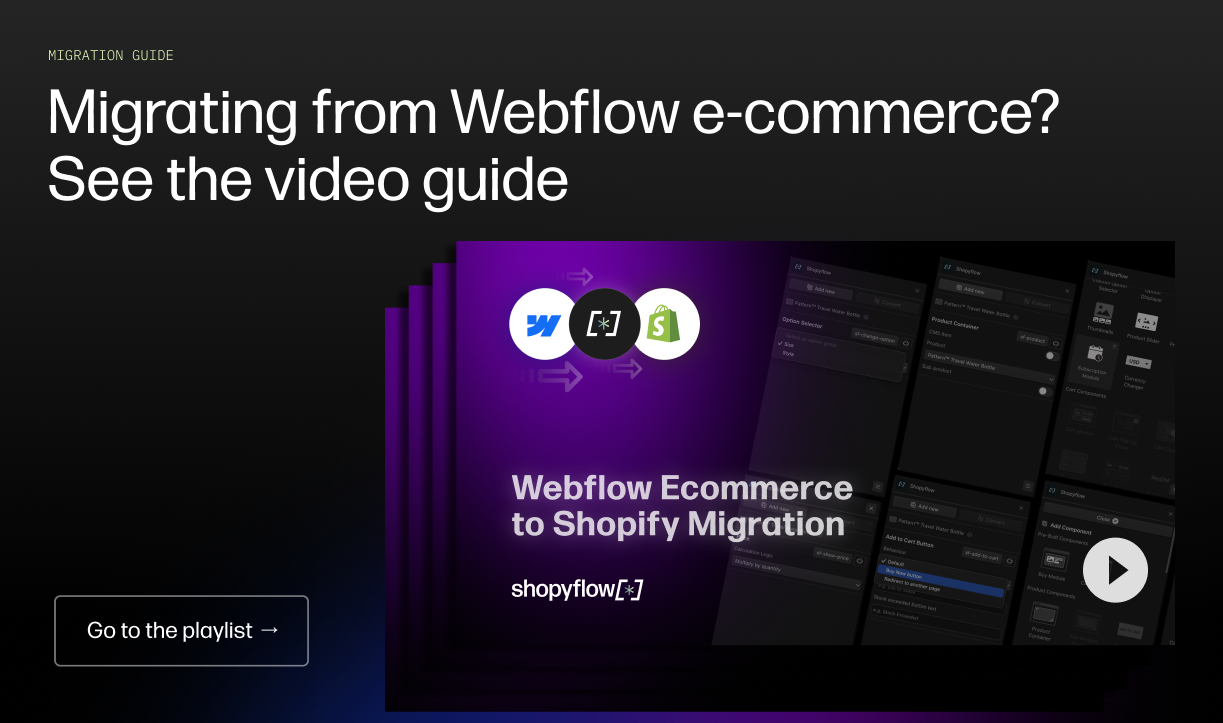
Our detailed guide covers everything you need to migrate from Webflow E-commerce to Shopify with Shopyflow:
- Setting up your Shopify account (if needed)
- Installing Shopyflow apps on both platforms
- Migrating products from Webflow E-commerce to Shopify
- Syncing Shopify data back to Webflow CMS
- Building product pages with Shopyflow components
- Understanding CMS structure and auto-sync features
The entire process typically takes 15-30 minutes for a complete setup.
Final thoughts
Traditional Webflow to Shopify migration is an outdated approach that forces businesses into unnecessary compromises. The old model assumed you had to choose between design freedom and e-commerce functionality – but that's no longer true.
Shopyflow eliminates the false choice by seamlessly integrating Shopify's powerful e-commerce backend with Webflow's unparalleled design frontend. You get enterprise-level e-commerce capabilities without sacrificing the visual brand experience that drives conversions.
The main benefits of going the Shopyflow route:
✔️ Cost efficiency: Skip the $5,000-$25,000 migration costs and ongoing developer dependency
✔️ Zero risk: No SEO impact, no business disruption, no design rebuilding required
✔️ Speed: Get up and running in days instead of weeks or months
✔️ Future flexibility: Keep both platforms and avoid vendor lock-in
✔️ Design preservation: Maintain every pixel of your custom Webflow design
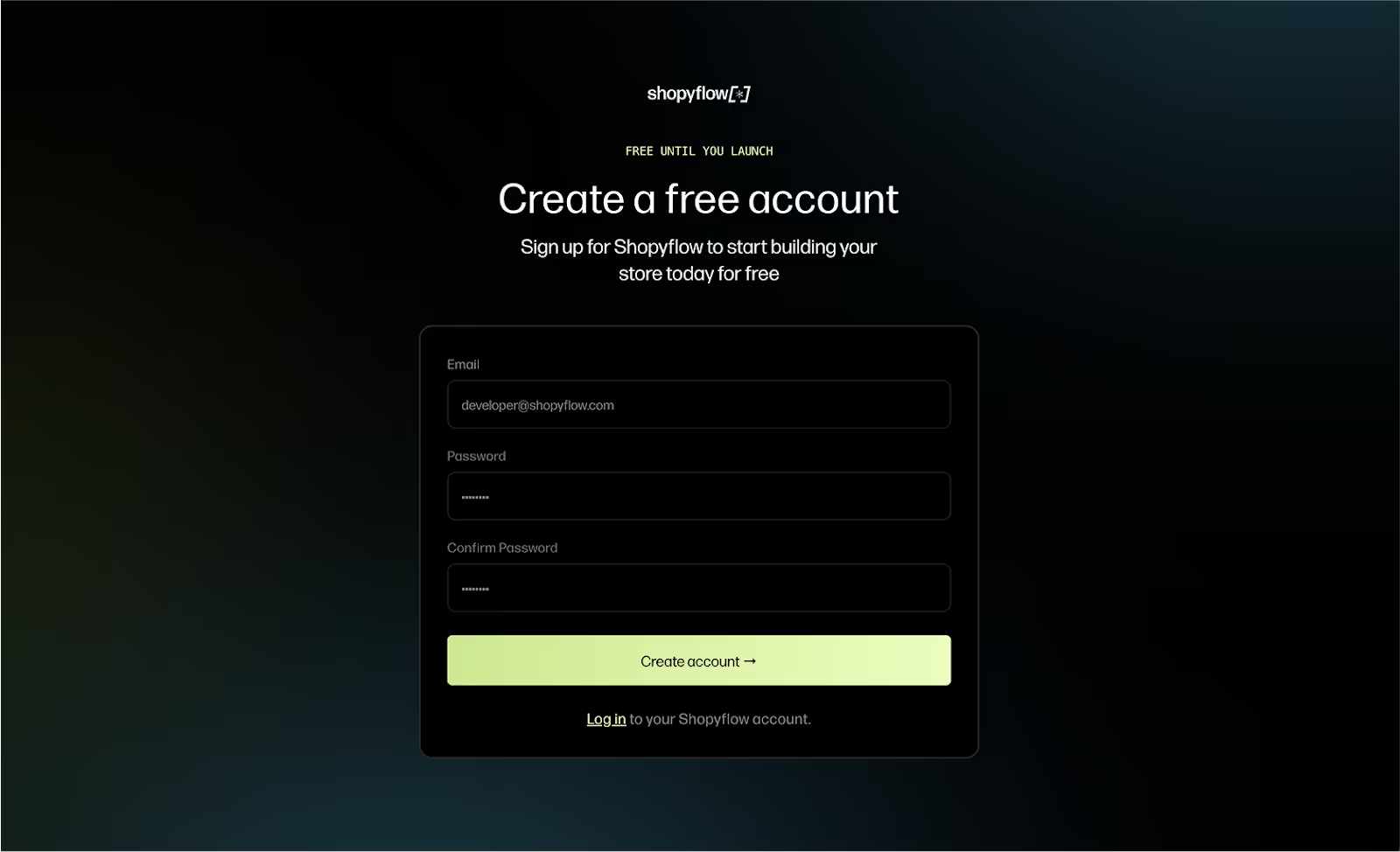
Start using Shopyflow for free and see how quickly you can transform your Webflow site into a powerful e-commerce store without compromising on design or functionality.